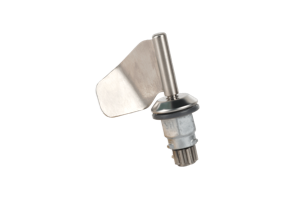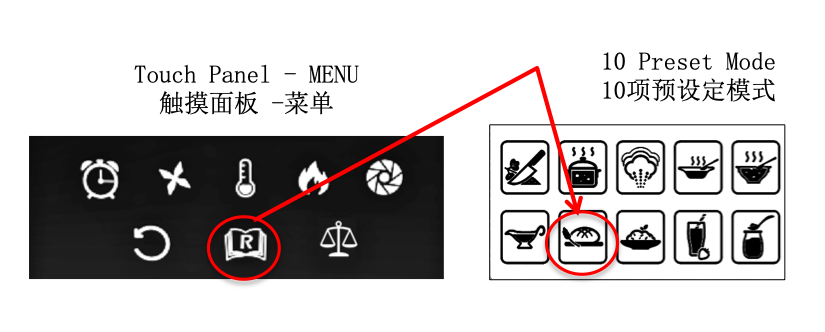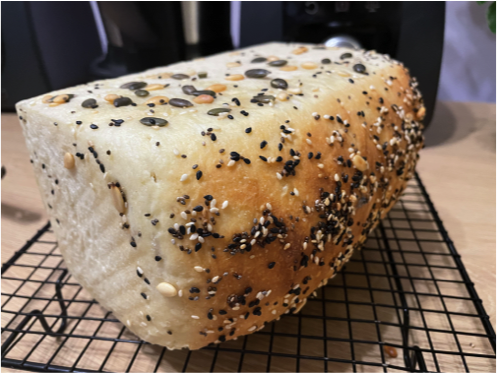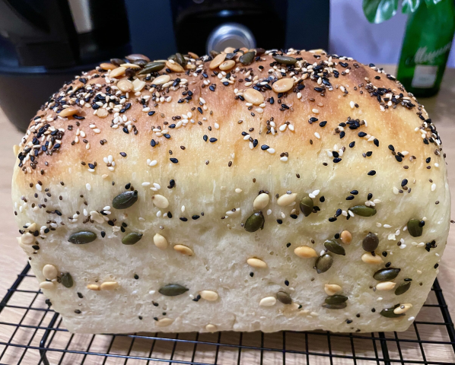- Install the Kneading Blade in the mixing jar.

WEIGHING INGREDIENT
- Place the mixing jar in the base unit, and press the scale button to start the weighing. The display will show “0 00 0” by default.
- Add ingredients: Weigh all the dry ingredients and follow by wet ingredients.
- Weigh the ingredients one by one in the mixing jar to show the exact value on the LCD screen.
- Press the scale button once it will reset to zero.
- Remove the ingredients, it will minus the weighing total value.
KNEADING
- After weighing all the ingredients, select KNEAD for preset mode 10 minutes OR you may use 3 minutes manual setting for quick kneading.
Select preset mode R - KNEAD and run the auto setting : Timer: 3 Minutes / Speed: 3 then continue Timer: 7 Minutes / Speed: 2
or
- You may use manual setting for quick kneading.
Settings: Timer: 3 Minutes / Speed: 3 / Temperature: 37°C
If the dough is sticky that it sticks to your fingertips, you need to add a little flour 1 – 2 tablespoon of flour and knead for 1 minute.

1st Rise (1 Hour)
• After kneading the flour, remove the dough from the jar. Put the jar up side down to a lightly floured work surface. Unlock the fixing bracket allows the dough drop on the work surface, then scrape down the dough that sticks on the kneading blade.
• On the floured surface and knead for 1 minute until the dough is soft and elastic.
• Grease the mixing jar or a large bowl with a little oil, transfer the dough back to the jar or the large bowl and cover tightly with plastic wrap.
• Let the dough rise for one hours.
• The optimal temperature for fermenting and proofing bread dough is 29 °C.
Punch and Rest 30 minute
• When the dough is ready, punching the dough down quickly releases any air pockets that have developed and helps your bread have a more consistent rise and texture.
• Gently fold the dough over on itself to release some of the gas and stretch the gluten.
• Continue to let the dough rise until it has doubled in bulk, about another half hour.
Shape the dough
• When the dough is well rested and has developed in strength, shape the dough, divide the dough in half and form each into a boule by gathering the dough into a seam on the bottom of the ball. You can make other shapes if you like.
Proofing 2nd Rise (30 - 45 minutes)
• Now that your breads have been shaped, they need time to rise again.
• Cover shaped dough with plastic wrap, continue to let the dough rise until it has doubled in bulk, about another 30 to 45 minutes.
- Towards the end of the rise, preheat your oven to 180°C or 200°C .
- Bake the bread for 30-35 minutes 180°C or 20-25 minutes 200°C, until it's light golden brown. Test it for doneness by removing it from the pan and thumping it on the bottom
(it should sound hollow).
- Cool baked bread in the pan for 10-15 minutes, then overturn pan and turn loaf out onto a cooling rack or folded towel to finish cooling. If you leave the bread in the pan for much longer than that, you’ll steam it, which may cause some parts of your loaf to go soggy.

4 servings
- Amount per serving
- Calories675
- % Daily Value *
- Total Fat 19.9g26%
- Saturated Fat 2.5g13%
- Cholesterol 0mg
- Sodium 1171mg51%
- Total Carbohydrate 105.4g39%
- Dietary Fiber 11.2g40%
- Total Sugars 7.5g
- Protein 20.8g
- Calcium 9mg1%
- Iron 45mg250%
- Potassium 322mg7%
- Vitamin D 0mcg0%
* The % Daily Value (DV) tells you how much a nutrient in a serving of food contributes to a daily diet. 2,000 calories a day is used for general nutrition advice.

